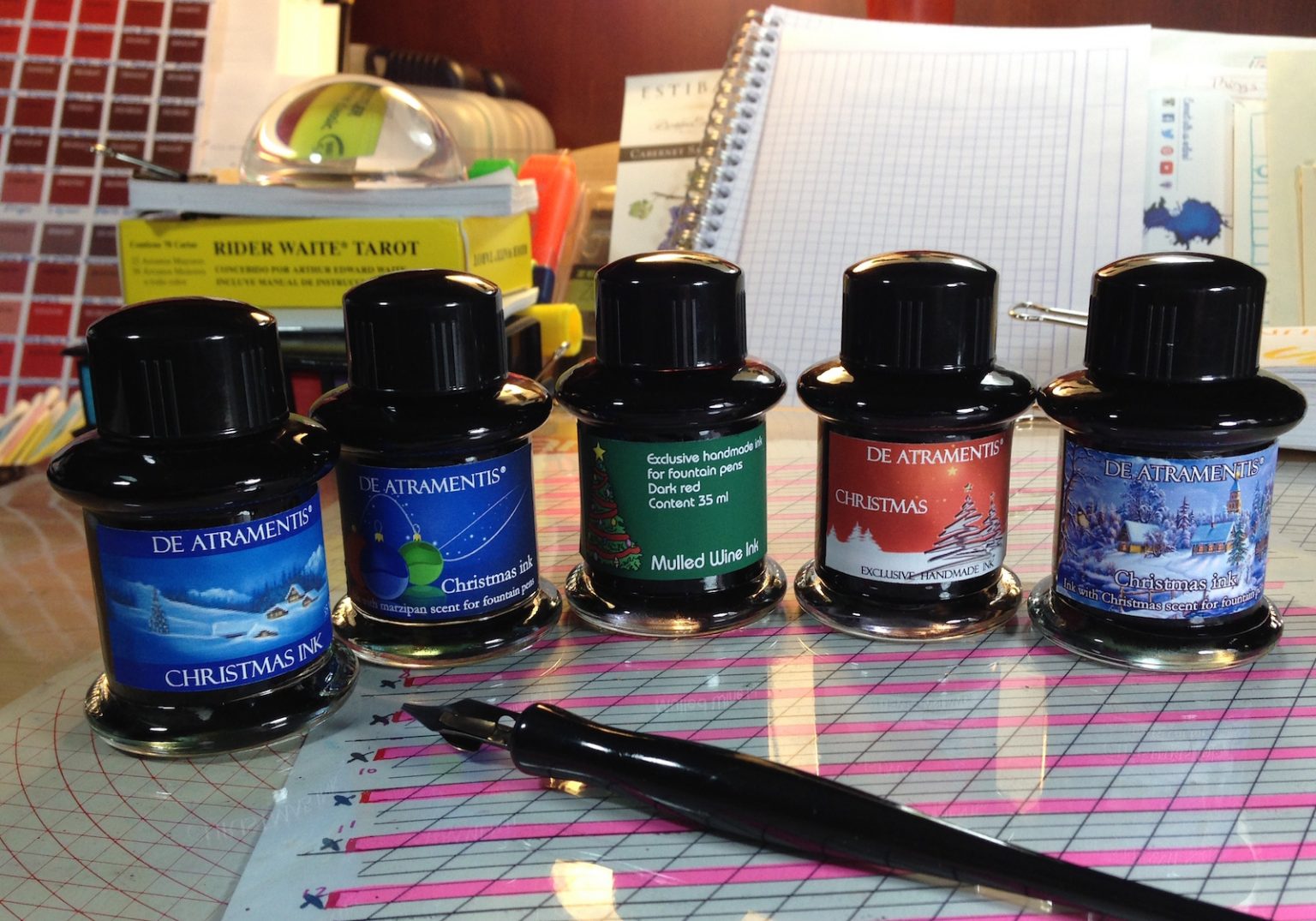If you have a fountain pen, you are trying to find the perfect ink for that pen. If you have many pens, you mix and match. This is a sort of art, chemistry, and something else… Why should you do it and how to do it properly?
Three colors everyone needs
If you have a fountain pen, its main purposes are: writing a diary of some sort, doodling, and signing important documents. Probably if you already bother to have a fountain pen, you will have more than one pen just for that.
The three most sought-after colors I know follow the same pattern. You need a quick-drying saturated blue-black color for your documents, some sort of dry vibrant orange for everything else, and a whimsical wet color like dark green or ruby for fun.
What colors will you buy? Probably you will take a massive cheap ink by the ink manufacturer you use for your blue-black. Then you will get a smaller yet incredibly elegant battle of some gem-inspired premium color of the same manufacturer for your orange. Finally, you will take some limited edition crazy colored ink for fun – it will look strange, have a strange bottle, will make your spouse frown and you will absolutely love it.
My main questions: how to start safely and why do you need more than that?
My starting point
Personally, for my basic colors, I just love Pilot iroshizuku series. I have yu-yake orange, asa-gao blue, kiri-some gray, and limited 100th edition blue-black ink. These are premium inks, which dry fast and have vibrant colors. Why those? Because I love my pilot pen, and I wanted vibrant Japanese inks. Similar inks by another Japanese company like Sailor are more nuanced, less vibrant and more expensive.
A great alternative is Pelikan Edelstein series. It is a german ink inspired by precious stones. While premium, it is not prohibitively expensive, For example, the mandarin color is very bright. There is also a similar series by Lamy called Lamy T53 crystal ink. What it lacks in orange, it has in shades of ruby.
Here you can see a comparison with tons of orange tints. To be honest, I am not sure you will be able to distinguish irushizuku from edelstein. I am not sure you should.
Both options are extremely friendly, not overly expensive but absolutely lucrative.
Modern chemists
Some companies make almost exclusively inks, have less attractive bottles and absolutely crazy colors. They offer hundreds of colors with crazy options like shadow, sheening, shimmering… See here for examples.
Here are some options:
Diamine, probably the least crazy of the specialized ink manufacturers. You can actually use it. But the colors you get are beyond the pallette of the mainstream pen manufacturers.
Papier plume, a shop in New Orleans that generates unique understated and elegant tints. It is famous for its iron-lace color that is a greenish dark grey but has many more colors to offer. Unless you have a broad nib, you might miss the fun in the unique undertones.
Noodler, a big producer of paints and colors. A staggering selection of colors that look almost home-made. Many of the colors are wet, e.g. will dry slowly. Some will cause performance issues in your pen unless you clean it daily.
Robert Oster, a huge name in ink catalogs. He got famous by fire-and-ice ink, which sheens from red to blue as it dried. The result is almost magical. Some of his colors are simply premium inks, but others are crazy and the selection appears endless.
Organics studio, the cutting edge of modern sheen. They do not make many colors, but the colors they make are very special, I would say extreme. Consider writers series. They take 30 seconds to dry, so you can enjoy every second.
These are not exactly the colors you will use for your signature. They may distract you from writing a diary. But for your doodling they are amazing.
Cheap inks
If you want to cover pages cheaply and reliably, do not buy the fancy colors I mentioned. Go for a working horse. Lamy T52 comes in 50 ml bottles. And while the colors themselves might be boring, the bottle is not. It actually has a roll of blotting paper in the bottle. Price-wise it will cost you about a fifth of the premium ink costs. Lamy T52 blue can be erased with a special eraser pen by Lamy which is cool. You may also buy a 60ml bottle of Pilot Namikin ink. It will not be fancy, but it will serve you well.
Go for the large manufacturers and simple colors. Fancy colors should be bought separately as I explained above.
Mixing your own ink
If you want to make a special tint relatively cheap you can mix inks in various proportions. Mixing inks is a troublesome area. You do not know if there will be small particles that can clog your pen, and you do not know which colors will work or how long they will stay as a mixture before going bad.
Kaweco inks are somewhere in the middle between the cheap and precious inks. They are not very expensive and not very nuanced, with very nice german consistency. If you want to mix inks, maybe you should start with Kaweco. For example, royal blue and palm green mix quite well, and so do ruby red and sunrise orange.
Another brand that plays well is J Herbin. It is a very old French company, dating from 1700 Paris. It offers just 35 non-toxic beautiful water-based dry colors made from natural dies. Some of the dies are scented like perfumes. And you can probably mix most of them with pretty spectacular results.
Some people want a very special color for their signature. Others write “thank you” notes for the customers that have a subtle scent. Some writers that experience writers’ block may start experimenting with colors instead of writing…
Wet inks
If you have a wonderful ink with beautiful color but it simply refuses to dry, you may need to change things. You can buy a different “dry” ink, use a fine nib with less ink, change the paper into something less smooth but more absorbing… Or use blotter.
A blotter is a stamp-like device, which allows to put a piece of porous blotting paper and consume the extra ink before it smudges everything.
So why should anyone use wet inks? Usually due to special effects.
Shinning is a color change as the ink dries. It needs to dry slowly.
Shimmer is the glitter of gold particles in the ink. They can clog your pen and are better suited for calligraphy. If you use Lamy Safari with steel nib, at least replacing the feed will be easy.
Water resistance is caused by using suspended particles rather than dyes. It can also clog your pen.
Shading is caused by strongly diluted dies. They change saturation based on the amount of ink at each point. Shading is the main reason to use wet inks with expensive pens.
Doodling
When doodling, the outlines are usually done with dry ink, and the shape is filled with wet ink. The properties of the wet ink can be properly used for example smudging the ink with water. Many of the ink tests deal with the effects of smudging the ink with water because it so useful for doodling.
If you want to doodle colorful images, you need way more than 3 colors. Probably you need all primary colors and some more. Doodling with inks does not look like anything else… You can do calligraphy, manga-like cartoons, almost water-color pieces, and more… By far the most popular theme are flowers. The outline is often drawn with a pencil. Then the flower is painted with ink and lots of water. Once the page dries, the outline is done again, this time with a very saturated solid line.
Some people invert the colors. They paint with white or very bright ink on dark surfaces. Or use fountain pen ink for highlighting.
Highlighter colors
Some people prefer to use fountain pens with wide calligraphic nibs for highlighting. Usually, this involves tints of yellow which are not available in other kinds of highlighters. Pelican M205 with its inks is an example. Noodler also provides highlighter ink. The main reason to do that is the shape factor: a fountain pen highlighter can be stylish. But once you do that, you can also use special inks.
While Tombow Kei Coat is not a fountain pen, it uses inks very much like a fountain pen would. Thus it can provide a very wide range of colors.
Six must-have colors
So, let us revise the color selection.
- You probably want blue-black or blue dry ink for most of your writing. Consider how much you write and balance cost vs quality.
- The bright orange color may be replaced with a tint of ruby. You can use it for doodling, annotations, underlines, titles. It is a very useful color.
- Consider a bright green or yellow highlighter. You can use it as a regular highlighter, but you can do other things like calligraphy and doodling.
- Add another dark saturated color to be used for signature and annotations. A unique color nobody will try to copy. Can be brown or purple or dark green.
- For your diary consider a wet color with shading or sheening, probably a bright blue or green. You have enough time to think while the color dries, and the process is more meditative this way.
- Take one more color, and go crazy with it. Use scented inks, make your own ink, or buy a limited edition ink. If it is safe for your pen (no clogging), use it on rare occasions with your most expensive pen. Enjoy it like you would enjoy whiskey or a cigar with the best paper money can buy.
Having six inks implies having six pens in your collection. One of these pens should be an expensive holy grail masterpiece. The others can be workhorses you trust.

